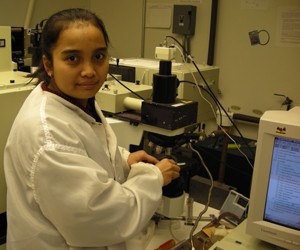
UC Engineering Researchers Uncover Factors That Control Ion Motion in Solid Electrolytes Coming to a Pacemaker Near You
University of Cincinnati researchers show for the first time that they can connect an increase in electrical (ionic) conductivity with flexibility of their networks. The same team of researchers discovered intermediate phases seven years ago in amorphous or disordered materials where networks are covalently bonded.
The teams results are presented in Fast-ion conduction and flexibility of glassy networks, to be published this spring in Physical Review Letters.
We find that when networks become flexible their electrical conductivity increases precipitously, says Deassy Novita. Now we will be able to chemically tune these materials for specific applications. For example, the batteries implanted in patients who have heart pacemakers make use of a solid electrolyte.
Novita is a third-year graduate student working in the lab of Punit Boolchand, professor of electrical engineering in the University of Cincinnatis College of Engineering. Originally from Indonesia and now a U.S. citizen, Novita began the ground-breaking research as part of her doctoral thesis.
"This system has been studied by about 35 groups all over the world over the past two decades. We are the first to make these samples in a dry state, says Boolchand. Most people who studied these materials produced them unwittingly in the laboratory ambient environment where the relative humidity is typically 50%, and that leads to samples that are so to speak in a wet state. By special handling of the materials, we were able to produce them in a dry state, where we can see the intrinsic behavior of these materials.
"The intrinsic behavior shows samples to exist in three elastic domains," Boolchand explains. "In the first domain, at low AgI (silver iodide) content (less than 9.5%) they form networks that are rigid but stressed. In the second domain, called the intermediate phase, at a slightly higher content of AgI (9.5 to 37.8%), they form networks that are rigid but unstressed. And finally in the third domain, at AgI content of 37.8% and higher, their networks become flexible."
The UC research team showed for the first time that such intermediate phases also exist in networks that are ionically conducting. In the flexible phase of these materials, silver ions move like fish through water, Boolchand says.
The next step in their research will be to understand why traces of water change the behavior of these electrolytes so drastically and to understand if the behavior observed here of three elastic domains is a general feature of all electrolyte glasses or is it peculiar to this very well studied material.
We think the behavior will be observed in general in solid electrolytes, says Boolchand.
The current work was supported by a National Science Foundation grant.
Published in Fast-ion conduction and flexibility of glassy networks, Physical Review Letters.
Authors:
Deassy I. Novita, Punit Boolchand, Department of Electrical and Computer Engineering, University of Cincinnati
M.Malki, Centre de Recherche sur les Matériaux a Haute Température, Université dOrléans, France
M. Micoulaut, Laboratoire de Physique Théorique de la Matière Condensée, Université Pierre et Marie Curie, Paris, France
Related Stories
OTR mural celebrates UC alumni success
April 4, 2025
The UC Alumni Association, UCAA, will mark its annual Alumni Celebration during its upcoming Alumni Week, April 7-13, with a community art project commemorating this year’s slate of alumni honorees receiving the organization’s top awards.
UC students combine engineering and design experience
April 3, 2025
At the University of Cincinnati, the College of Design, Art, Architecture and Planning hosted a design competition with HAAG-Streit USA, where students were tasked with designing an ophthalmology workstation that is accessible and able to be incorporated into retail settings. Caleb Loayza, a mechanical engineering student at the College of Engineering and Applied Science, and Guy Mueller, an industrial design student, combined their expertise and took home first place.
UC Honors students gain hands-on research experience
April 1, 2025
The Biomedical Research and Mentoring Program is open to any University Honors Program students. The faculty mentors are typically from UC’s College of Medicine or Cincinnati Children's Hospital.
